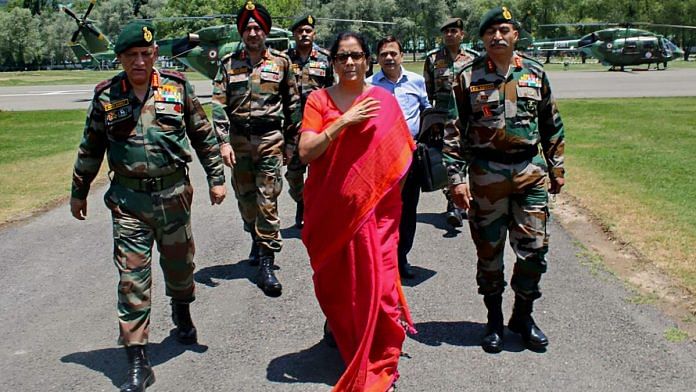New Delhi: After the Balakot air strikes and the subsequent air battle between India and Pakistan on 26-27 February, India’s three services were expecting an increase in the budgetary allocation for defence. But they were left disappointed as Finance Minister Nirmala Sitharaman kept India’s defence budget unchanged from the interim budget at Rs 3.18 lakh crore.
The lack of change in the budget figures means that the actual hike in the defence budget is just 6.87 per cent more than the revised estimate of Rs 2.98 lakh crore for the financial year 2018-19. The allocation, however, is barely enough to cover inflation costs.
Sitharaman has rejigged the allocations under various heads — capital, revenue and civil. There has been a small reduction of Rs 14 crore in the capital budget and an increase of Rs 3,416 crore in revenue allocation, which has been adjusted under the civil and miscellaneous heads.
The only relief for the armed forces is that Sitharaman, who served as defence minister in the first Narendra Modi government, has removed the customs duty on defence products, which means that the services will not have to pay anything as import duty as done since 2016.
Although in 2016, the ministry had assured the Services they will get back the customs duty paid, it never happened. “It was like our purchasing power had decreased by 30 per cent because of the customs duty paid,” a top officer in the defence establishment told ThePrint.
New projects in limbo
However, the services were hoping for an increased allocation because they are in the midst of a modernisation process, with projects related to new submarines, helicopters and fighter aircraft waiting to be kicked off.
“We understand that there are constraints but we were expecting the minister to actually increase the allocation from the interim budget,” a senior uniformed officer told ThePrint on the condition of anonymity.
The Indian military is facing a collective threat from Pakistan and China, who are focussing heavily on modernising their armament. Last year, China had raised its defence budget by 8.1 per cent to 1.11 trillion yuan (about $175 billion), which is four times India’s defence budget.
Also read: Narendra Modi govt wants a strong military, but its defence budget can’t guarantee that




Towards the end of UPA II, when high economic growth and tax buoyancy had both receded, Dr Singh told a meeting of top military officers, Gentlemen, we will have to cut our coat according to the cloth. After five years of an underperforming economy, that holds true for India even now. First, in terms of better understanding of what it costs to keep India safe, we should add the figure of pensions as well. Our pension bill is roughly equal to Pakistan’s defence budget. 2. Comparisons with China’s defence spending are of limited relevance, although it is our foremost adversary. It has a much larger economy, and it is facing the United Stares, whereas India only faces an occasional tweet from the great man. 3. India has forbidding development challenges. Funding those should be a higher priority than being ready to fight a two front war, with 45 squadrons of grotesquely expensive fighter aircraft, among other things. Our foreign policy should better reflect our national imperative of removing mass poverty and becoming a middle income society. A GDP of $ 5 trillion would still mean a per capita income of about $ 3,600, which is not really middle income.